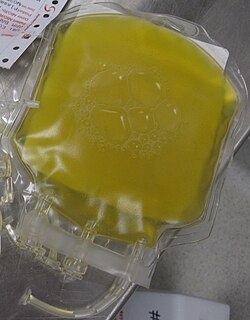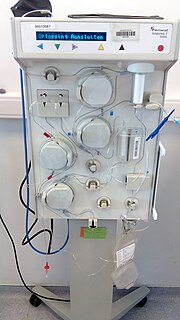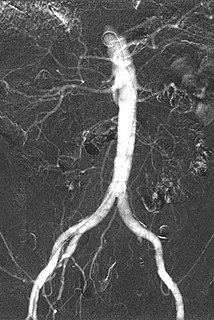Related Research Articles

Clinical chemistry is the area of chemistry that is generally concerned with analysis of bodily fluids for diagnostic and therapeutic purposes. It is an applied form of biochemistry.

Blood plasma is a yellowish liquid component of blood that holds the blood cells of whole blood in suspension. It is the liquid part of the blood that carries cells and proteins throughout the body. It makes up about 55% of the body's total blood volume. It is the intravascular part of extracellular fluid (all body fluid outside cells). It is mostly water (up to 95% by volume), and contains important dissolved proteins (6–8%) (e.g., serum albumins, globulins, and fibrinogen), glucose, clotting factors, electrolytes (Na+, Ca2+, Mg2+, HCO3−, Cl−, etc.), hormones, carbon dioxide (plasma being the main medium for excretory product transportation), and oxygen. It plays a vital role in an intravascular osmotic effect that keeps electrolyte concentration balanced and protects the body from infection and other blood disorders.

Serum is the fluid and solute component of blood which does not play a role in clotting. It may be defined as blood plasma without fibrinogens. Serum includes all proteins not used in blood clotting; all electrolytes, antibodies, antigens, hormones; and any exogenous substances. Serum does not contain white blood cells (leukocytes), red blood cells (erythrocytes), platelets, or clotting factors.
Calcium ions (Ca2+) contribute to the physiology and biochemistry of organisms cell. They play an important role in signal transduction pathways, where they act as a second messenger, in neurotransmitter release from neurons, in contraction of all muscle cell types, and in fertilization. Many enzymes require calcium ions as a cofactor, including several of the coagulation factors. Extracellular calcium is also important for maintaining the potential difference across excitable cell membranes, as well as proper bone formation.

Triiodothyronine, also known as T3, is a thyroid hormone. It affects almost every physiological process in the body, including growth and development, metabolism, body temperature, and heart rate.

Plasmapheresis is the removal, treatment, and return or exchange of blood plasma or components thereof from and to the blood circulation. It is thus an extracorporeal therapy.

There are 37 known isotopes of iodine (53I) from 108I to 144I; all undergo radioactive decay except 127I, which is stable. Iodine is thus a monoisotopic element.
Blood volume is the volume of blood in the circulatory system of any individual.
Iodine-125 (125I) is a radioisotope of iodine which has uses in biological assays, nuclear medicine imaging and in radiation therapy as brachytherapy to treat a number of conditions, including prostate cancer, uveal melanomas, and brain tumors. It is the second longest-lived radioisotope of iodine, after iodine-129.
Plasma protein binding refers to the degree to which medications attach to proteins within the blood. A drug's efficiency may be affected by the degree to which it binds. The less bound a drug is, the more efficiently it can traverse cell membranes or diffuse. Common blood proteins that drugs bind to are human serum albumin, lipoprotein, glycoprotein, and α, β‚ and γ globulins.
Depyrogenation refers to the removal of pyrogens from solution, most commonly from injectable pharmaceuticals.
Chromatography is a physical method of separation that distributes the components you want to separate between two phases, one stationary, the other moving in a definite direction. Cold ethanol precipitation, developed by Cohn in 1946, manipulates pH, ionic strength, ethanol concentration and temperature to precipitate different protein fractions from plasma. Chromatographic techniques utilise ion exchange, gel filtration and affinity resins to separate proteins. Since the 1980s it has emerged as an effective method of purifying blood components for therapeutic use.

Rilpivirine, sold under the brand names Edurant and Rekambys, is a medication, developed by Tibotec, used for the treatment of HIV/AIDS. It is a second-generation non-nucleoside reverse transcriptase inhibitor (NNRTI) with higher potency, longer half-life and reduced side-effect profile compared with older NNRTIs such as efavirenz.

Thyroid hormones are two hormones produced and released by the thyroid gland, namely triiodothyronine (T3) and thyroxine (T4). They are tyrosine-based hormones that are primarily responsible for regulation of metabolism. T3 and T4 are partially composed of iodine. A deficiency of iodine leads to decreased production of T3 and T4, enlarges the thyroid tissue and will cause the disease known as simple goitre. The major form of thyroid hormone in the blood is thyroxine (T4), which has a longer half-life than T3. In humans, the ratio of T4 to T3 released into the blood is approximately 14:1. T4 is converted to the active T3 (three to four times more potent than T4) within cells by deiodinases (5′-iodinase). These are further processed by decarboxylation and deiodination to produce iodothyronamine (T1a) and thyronamine (T0a). All three isoforms of the deiodinases are selenium-containing enzymes, thus dietary selenium is essential for T3 production.

Iobitridol is a pharmaceutical drug used as a radiocontrast agent in X-ray imaging. It is injected into blood vessels, joints, or body cavities such as the uterus, and filtered out by the kidneys. Its most common adverse effect is nausea. Severe allergic reactions are rare.

Ioxaglic acid is pharmaceutical drug used as an iodinated contrast medium for X-ray imaging. It has low osmolality, typically resulting in fewer side effects than high-osmolality media. It is manufactured by Guerbet, but marketing in the US has been discontinued. As of 2021, it may still be available in some European countries.
Blood plasma fractionation refers to the general processes of separating the various components of blood plasma, which in turn is a component of blood obtained through blood fractionation. Plasma-derived immunoglobulins are giving a new narrative to healthcare across a wide range of autoimmune inflammatory diseases. This widespread applicability is anticipated to leverage market prospects for plasma fractionation, pegged to witness a noteworthy 7% CAGR. COVID-19 pandemic is expected to generate growth opportunities for the plasma fractionation market.

Lenvatinib, sold under the brand name Lenvima among others, is an anti-cancer medication for the treatment of certain kinds of thyroid cancer and for other cancers as well. It was developed by Eisai Co. and acts as a multiple kinase inhibitor against the VEGFR1, VEGFR2 and VEGFR3 kinases.

Cabotegravir is a medication used for the treatment of HIV/AIDS in adults. It is available in form of tablets and as an intramuscular injection, as well as in an injectable combination with rilpivirine under the brand name Cabenuva. The injection forms are applied once a month or once every two months.

Carbon dioxide angiography is a diagnostic radiographic technique in which a carbon dioxide (CO2) based contrast medium is used - unlike traditional angiography where the contrast medium normally used is iodine based – to see and study the body vessels. Since CO2 is a non-radio-opaque contrast medium, angiographic procedures need to be performed in subtractive angiography (DSA).